Search results
56 results found.
56 results found.
I want everyone to stop for a moment and think of Audrey Hepburn. Yes, one of the most divine women ever to set foot on earth. Just writing her name is like inhaling a waft of moonflowers and heliotrope from the Isles of the Blest.
Now I want you to imagine her — just for a second, because this hurts — becoming old, neglected, and feeble. Not demented, just left to deteriorate at random. You know: The soup stain on the blouse, the dirty hair, the shuffly slippers instead of shoes, the drooping slip, the general all-purpose “Just don’t care anymore, can’t be bothered, nothing matters anyway. What pile of unopened bills on the kitchen floor? What half-eaten cans of tuna in the laundry basket? A mouse in the refrigerator? Is it alive?”
Now I want you to stop for a moment and think of Venice.
Now put the two pictures together. Not good. Not good at all.
I hinted in my last post at a certain laissez-faire atmosphere which has taken over what I still am determined to consider the Audrey Hepburn of cities. Over the years, signs of distressing degradation have been noticed, and even reported to the authorities — each sign existing in its own little capsule in the municipal consciousness, just as each sign of personal neglect can be passed over by benevolent or apathetic eyes. Each, of course, explained or excused because no ghe xe schei.
Then suddenly the total of them all reveals itself as appalling.
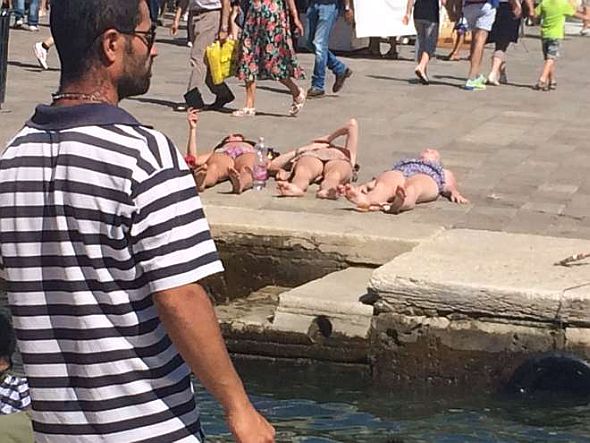
This revelation seems to have hit a lot of people lately, if the Gazzettino is anything to go by. And yes, great lamentations continue to rise from the Venetians concerning the tourists. But if tourists are the perpetrators, the municipal non-authorities are the enablers.
First, the tourists. When I use the word, I’m not referring to their quantity, which is distressing though not difficult to understand, but their quality, which utterly bewilders me.
Yes, of course there are millions of wonderful tourists here all the time. And I don’t want to get into an arm-wrestling match over percentages, or what constitutes “quality tourism,” or the God-given universal human right to come to Venice whenever you want.
But I have to say that I do not perceive a human right to come to Venice to DO whatever you want.

Every few days some novel behavior appears which the star of the story inexplicably considers just fine, behavior which in their own city is probably regarded as offensive and possibly also illegal. Here the same behavior is also regarded as offensive, and is often illegal, and yet Venice, especially in the summer, and especially this summer, seems to attract a type of tourist who thinks that former Queen of the Seas is more fun than the locally-much-reviled Disneyland, although the comparison isn’t very useful considering that the Magic Kingdom is more strictly run than your average penitentiary. I mean that as a compliment.
Graffiti-sprayers and sun-bathers in the Piazza San Marco are no longer any special big deal, repulsive as they are. But this year has kicked it all up a notch. There was the Indian family which hunkered down in the Piazza San Marco to cook lunch on a camp stove. The man who decided to beat the heat by stripping down to his underwear, blithely wandering the streets in his Jockey shorts, or the European equivalent thereof.
A young couple, all tuckered out, who spread their towels on the street in a nice patch of shade and lay down to sleep. A man who decided to scale the Doge’s Palace, demonstrating a free-climbing skill that would have been admirable if he hadn’t been clinging to pieces of marble and statues hundreds of years old.
A tightrope walker who strung his cord between two lampposts along the Zattere. Carnal knowledge on the Scalzi bridge.
Do these people think that it’s Carnival here all year? Did they come all the way to Venice just to do this, or are they merely responding to some sudden impulse? Or do they intuit, by some imperceptible herd sensitivity, that Venice has become something like homeroom with no teacher, all the time?

Now comes the latest: Two male visitors in the Piazza San Marco whose bursting bladders brooked no delay. So they relieved themselves into a garbage can. As in many of the above-noted cases, it was broad daylight.
Much of this revolting behavior is something you’d expect — or not be surprised — to see on the Bowery, Skid Row, the Tenderloin, or whatever is the current term for the devastated section of your city.
But this is not them. Nor is it — despite the sun and water and boats — Panama City Beach on Spring Break.
This is a three-square-mile World Heritage Site. It’s more like the Louvre, with sun and water and boats.
So if whatever you’re about to do would be disgusting or ridiculous or rude in the Louvre — or even in Horse Hoof, Kansas, or especially in the much-maligned Disneyland — it would be likewise here.

So much for the tourists.
Yet, as the always perceptive Davide Scalzotto noted in a brief essay in the Gazzettino, if the city has begun to look like a slum (I paraphrase), people will act as if it’s a slum. I believe there are important studies which support this statement. I won’t start a list here of the dreadful deterioration to be seen just about anywhere because it’s too depressing and also because it would make anybody want to scream.
Hardly any money has been spent over the past decade or more on maintenance, let alone improvement, and now we know why. It’s because the city fathers were pulling out the money for MOSE through virtual pneumatic tubes for their own purposes. And the state funds that come via the Special Law for Venice, which was instituted in 1973 specifically to finance measures to protect the city and its environment, are always too little, and too late.
Are there police? Of course, but not nearly enough. Are there laws? Of course, but probably too many. Considering that it’s impossible to enforce them all, they get enforced on an as-needed basis. No wonder the once Most Serene Republic has come to resemble Head-Smashed-In Buffalo Jump.
But let’s say somebody gets arrested — it does happen, though it isn’t always, or even usually, a tourist. Not long ago, we read about a crippled beggar well-known around the crowded streets of Venice and the beaches of Jesolo, just across the lagoon. Hold your sympathy. The story had to do with the fact that at quittin’ time the homeless, 47-year-old Romanian straightened up, brushed himself off, and briskly walked toward wherever he was going that night. When an angry citizen’s photograph was published — the lame walk? The blind see? Is it, in fact, a miracle? — the beggar was hauled in and charged with…. what? Offending public decency? Exploiting the public’s natural compassion? Faking it? What crime, exactly, had he committed?
None. The judge ruled that it is not against the law to beg, even if in the process you callously counterfeit a pitiful condition to earn lucrative sympathy. The mendicant paid an administrative fine, and the judge gave him his cane back.
So: There is no law that forbids a person to present himself as something he is not. I guess I already knew that. We had a mayor who presented himself as honest, but he was not. He was sentenced to four months of house arrest, but his crime wasn’t having pretended to be honest, but for having taken bribes. Ergo, why should somebody be punished for pretending to be a cripple, staggering along, doubled over, supported only by his trembling cane?
So we could all start faking it and still be fine. I know people who pretend to be intelligent, or caring, or lots of things they’re not. I could walk around pretending I was Elaine Stritch and I’d never be arrested, at least not until I started belting out “I’m Still Here” on the street.
Here is the YouTube link: http://youtu.be/CFzmVYNItjU
I started with Audrey and I’ve ended up with Elaine. My God: It’s the story of Venice in two names. Maybe “I’m Still Here” ought to be the new national anthem of Venice.
Except that it shouldn’t have to.
My next post, barring some unforeseen calamity, will take us back to happier topics. I’ve had more than I can take of all this tsuris.

July 29, as all the world knows, is the feast day of Santa Marta. Or in any case, now the world knows.
She is essentially forgotten here; her church has been deconsecrated, swallowed and partially digested by the Maritime Zone, and her celebration — once one of the greatest of the many great festivals here — is gone forever. Only a painting by Canaletto brings us the tiniest (and darkest) glimpse of what was once a very big night in Venice. Her name today is used mainly to refer to the adjacent neighborhood.
The reason I didn’t get this post finished by July 29 is because I got lost reading assorted accounts, some of them first-hand, about this uber-fest. It didn’t take me long to conclude that the fabled feast of the Redentore, which has remained a very big deal, was really nothing so remarkable compared to Santa Marta’s. The Redentore had fireworks, it’s true, but Marta had fresh sole.
Fish was an excuse for a colossal boating party? Why not? The Venetian civil and religious calendar was bursting with events of every type and voltage. A very short list would note the festivals of Santa Maria della Carita’, Palm Sunday, S. Stefano, “Fat Thursday,” May 1, or the Doge’s Visit to the Monastery of the Virgins, S. Isidoro, the taking of Constantinople (1204), the regaining of Candia (1204), S. John the Baptist “Beheaded,” Sunday after Ascension Day, the victory over Padua (1214), the defense of Scutari (1479), the victory of Lepanto (1571), S. Rocco, Corpus Domini, the victory of the Dardanelles (1656), and the conquest of the Morea (1687). These are just a few of the major events; the Venetians also commemorated defeats. There was something going on almost every day.
But there was always room for more, and although Santa Marta couldn’t claim to have sponsored any particular victory, discovery, or other noteworthy occurrence, her feast day conveniently fell in the period when the weather was suffocatingly hot, and the sole were in season. Plus, her church was located on a little lobe of land facing lots of water, and there was a beach. All this says “Put on your red dress, baby, ’cause we goin’ out tonight” to me.
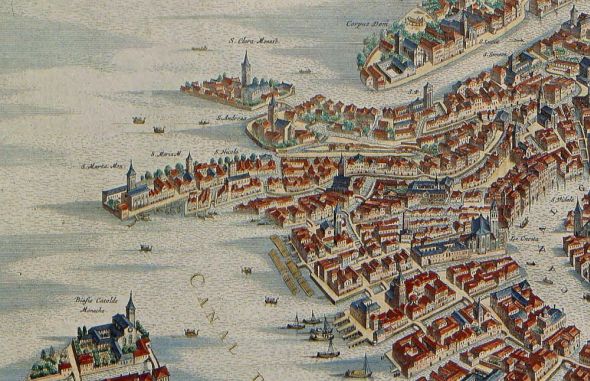
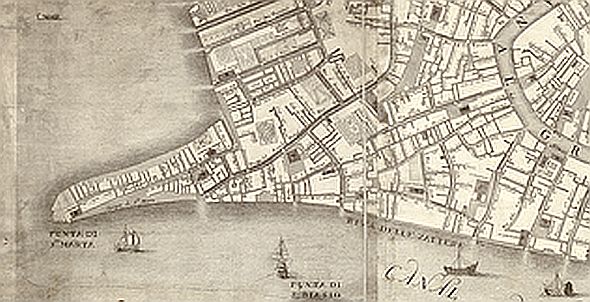
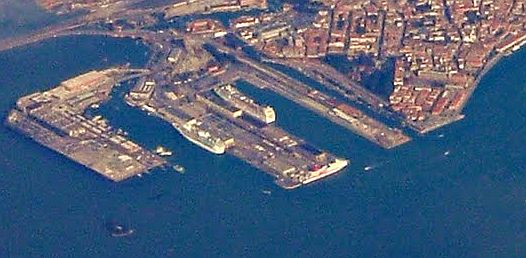
The basic components were: Everybody in Venice, either on land or on the water, regardless of social station or disposable income; every boat in Venice — so many boats you could hardly see the water, festooned with illuminated balloons and carrying improvised little arbors formed by frondy branches; music, song and dance, and lots and lots of fresh sole.

July is the season for sfogi zentili, or Solea vulgaris, and while the Venetians could bring their own vittles, plenty of them also bought the fish which had just been saute’d, either on the beach or on the street by enterprising entrepreneurs. If you were really in luck, there would be moonlight, too.
The best and most famous chronicler of this party was Giustina Renier Michiel, who was born in 1755 and belonged to several patrician Venetian families. She spent 20 years researching her six-volume work, Origine delle Feste Veneziane (1830), but the fact that she had personal memories of many of these events makes her books exceptional.
I started to translate what she wrote about the feast of Santa Marta, but she went on so long, and her style sounded so curious in English, that I became tired and discontented. So I’m going to give some bits and summarize the rest. Anyway, it’s clear that the event was so phenomenal that even people who saw it finally gave up trying to describe it adequately or coherently.
Here is her version of how the festa was born:
“In the old days many groups went out in certain boats to fish for sole, the best fish that one eats in July. (Lino concurs with date and description.)
“And in the evening they would go back to the beach by the church of Santa Marta and feast on the fish, enjoying the cool air that restored their depleted strength after the labor of fishing, as well as the heat of the season.
“Later on, as the population became richer, and softness set in, the work of fishing was left to the poor people, who had to do it in order to live, and what used to be a fatiguing labor changed into a singular entertainment.”
My version: It didn’t take long for everybody else in Venice to say “A cookout on the beach? We’re on our way.” Everybody started making Santa Marta’s Eve a great reason to head for her neighborhood and eat fish, garnished and enlivened by the classic saor sauce of sweet-sour onions. It was like a gigantic clambake, a barbecue, a luau, for thousands and thousands of people.
Obviously the beach was too small for everybody, so the boats made themselves at home on the Giudecca Canal, “whose waters could only be seen in flashes, and almost seemed to be strips of fire, agitated by the oars of so many boats that covered the water and which doubled the effect of the lights which were on the boats.”
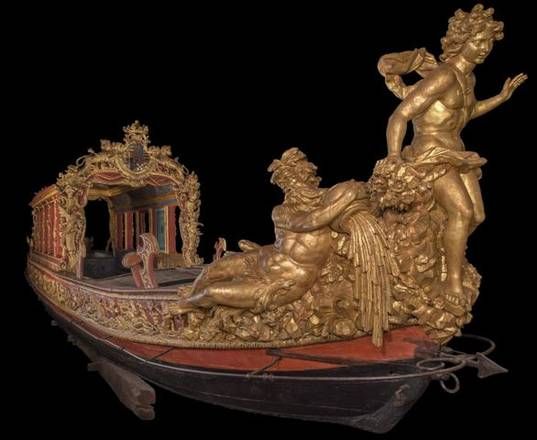
The patricians came out on their fabulously ornate peote, and often carrying musicians who sang and played wind instruments. There were scores of the classic fishing boat called a tartana, draped with variously-colored balloons and loaded with laughing families and friends. There were artisans in their battellos, and hundreds of light little gondolas, and plenty of gondolas da fresco, and there were even the burchielle, the heavy cargo boats that carried sand and lumber. If it could float, it joined the vast confusion of boats being rowed languidly in every direction, or tied up along the Zattere where there was just as much happy turmoil ashore.
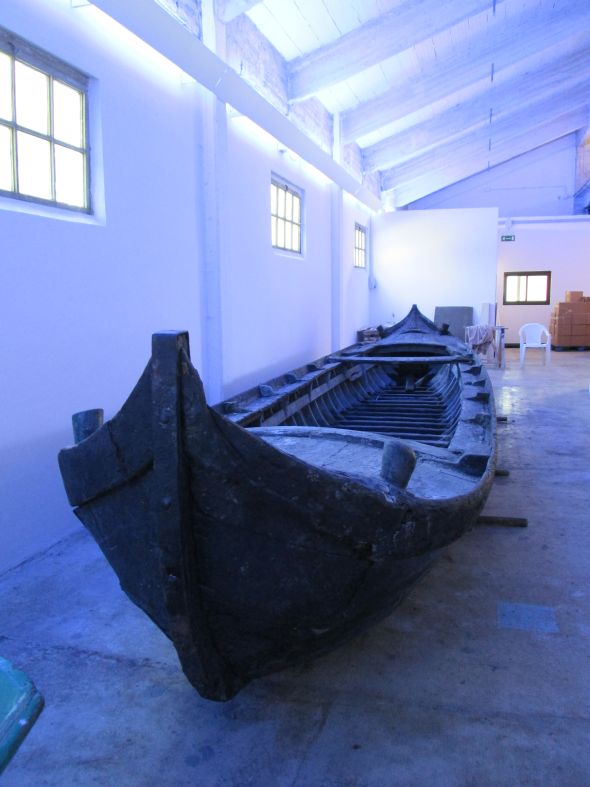
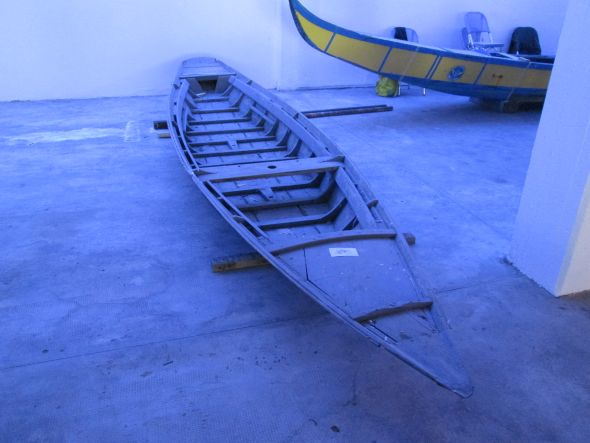
The Gazzetta Urbana of 1787: “Along this riva, called the Zattere, the cafe’s and bars are crammed to overflowing with people. There are tables set up outside their doors, and everything is so lit up that it seems to be daytime.
“The passage (of people) in all the streets leading to Santa Marta was dense and continuous, and the splendid gathering at the Caffe of San Basegio, at the head of the Zattere, formed a separate spectacle, in which our Adriatic beauties, wearing modern shimmering caps in the Greek style, ornamented with plumes, inflamed with their glances the hearts of the young men who, like butterflies, always flutter around the flare of a woman’s beauty.”
Also amid the throng were little ambulatory kitchens — a man with a basket of sole would put two stones on the ground, then lay two bunches of sticks crosswise on them, light a little charcoal under them, pour some oil in a pan, and stand there bawling for business. He kept a container of saor ready to put on the fish.
Renier Michiel: “The entire length of this district was full of a grand concourse of people, moving toward the piazza of Santa Marta which was the best vantage point to enjoy the spectacle. On the piazza there were more food vendors, some of them selling roast chicken. There is a racket of cups, plates, the yells of the vendors, the music from the boats on the water. Every house is transformed into a sort of tavern where people eat and drink, and there was perfect joy and harmony.”
“Perfect joy and harmony”? How can this be (apart from the fact that she was looking back on it, years later, when the festival was gone forever)?
I think it’s because Santa Marta was secretly taking care of people. She is the patroness of cooks, butlers, laundry-workers, servants, housewives, and waiters. Though I suppose you could just say “housewives” and leave it at that.
Because as Santa Marta, and 99 percent of women on earth, can attest, while some people at a party are laughing and scarfing the canapes and playing with the dog and singing comic songs and reveling in industrial-size helpings of joy and harmony, there’s at least one person somewhere in the background doing everything to make it seem as if there is absolutely nothing that needs to be done.
And I have no doubt that when the boats went home at dawn on July 29, there was somebody who had to put the boat away and swab the bilge and pick up every single fishbone, as well as deal with the dishes and the wine- and saor-stained clothes. Behind every great saint is somebody with a bucket and mop, I say.
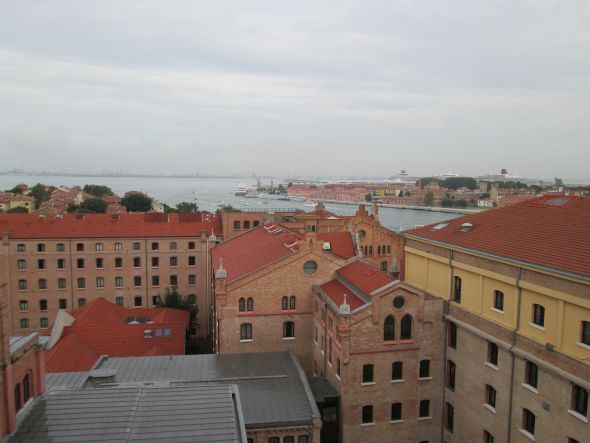

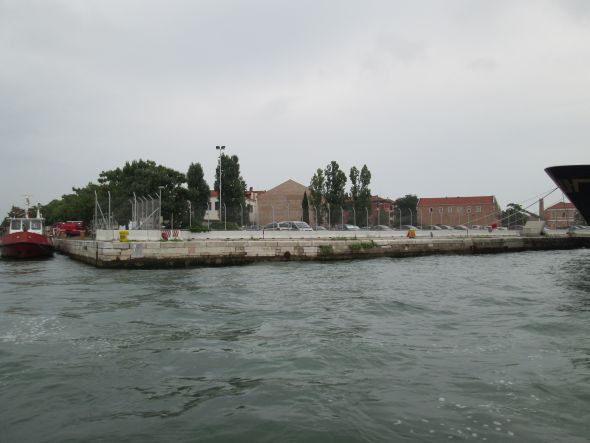

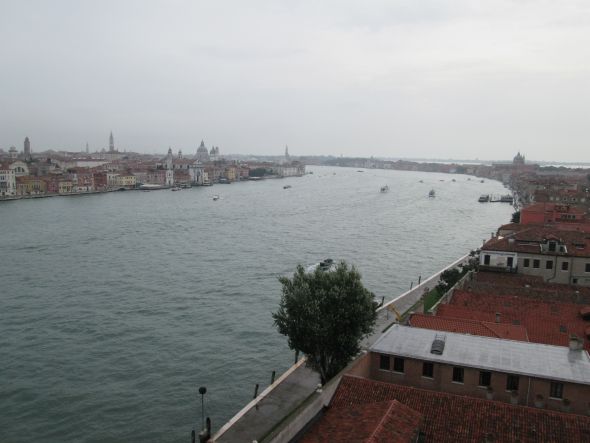
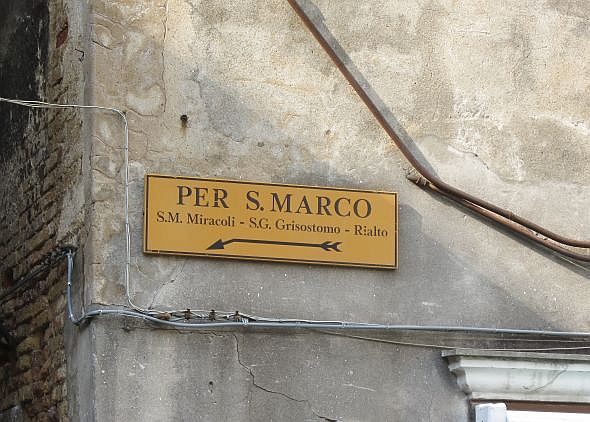
Everyone has been so busy recently dealing with the nizioleti and washing and bleaching and ironing them, so to speak, that there hasn’t been much time to worry about anything else.
But now that we’re looking at the walls, we can see that something is going on that’s almost as disconcerting as the rewriting of the bedsheets.
It has to do with the yellow signs attached to assorted walls around the city whose arrows indicate the right direction to take in order to reach the major points of interest: San Marco, Rialto, Accademia, and a few other points near and far. There aren’t enough of these signs, and they’re not always positioned at the really necessary spot, though admittedly the intentions are good. But that isn’t the problem.
Unlike the nizioleti, which were in danger of being un-Venetianized, their yellow cousins represent a bureaucratic convolution which is much knottier than whether to use double or single consonants. And these yellow cousins don’t even have a cute nickname, unless you want to call them “mystery” (giallo, in Italian — the same word as yellow).
The problem is that they too need therapy — to be repaired, cleaned up, made uniform throughout the city, and generally titivated. But they have no parents, no guardian, no adult supervision. Nobody is responsible for them. Nobody even knows who put them up, or when.
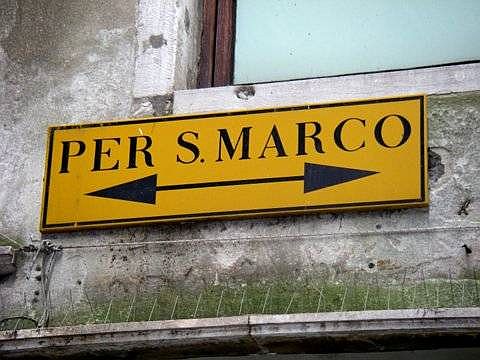
This more than usual strangeness came to light when a merchant wrote to the city to complain about another merchant who had made a little personal project of blacking out the words on certain normal signs, and installing a new yellow sign — example: “Per Rialto” — with an arrow pointing in the direction of his shop. This had been going on for six years, which I think demonstrates an amazing forbearance on the part of his competitors.
There’s a saying which describes this kind of behavior: “The devil makes the pots, but he doesn’t make their lids.” Which is to say that something skulduggerous might very well succeed up to a certain point, but it cannot remain concealed forever. You may be cooking along at a great rate on some sketchy project, but it will boil over, dry up and burn, catch fire, develop botulinum toxin, or otherwise eventually be discovered.
However, when the annoyed merchant wrote to ask the city to intervene to correct this delinquency, the city did not reply with the traditional comment no ghe xe schei.
Instead, the particular department (Urban Maintenance) informed him that “The Department of Public Works doesn’t install the yellow signs, and they don’t conform to the current regulations. In all of the Historic Center a signage indicating the most usual touristic routes are the object of continuous variations and tampering. It is impossible to determine the pre-existence, provenance, or eventual proprietors of these signs.
“Whatever intervention,” the reply continued, “requested by citizens or commercial operators for maintenance, cleaning up, renovation, or new installation, can only be made after a decision shared by the assessori (councilors) of Public Works, Commerce, Tourism, and Productive Activity” (the same thing as commerce, but different).
To sum up: We don’t know whose they are, but they’re not legal. We don’t know who put them there, but you can’t touch them. These are deep waters, Watson.
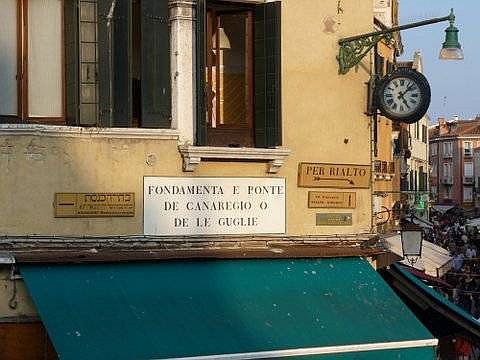
But Alessandro Maggioni, the assessore of Public Works, wanted to clarify the situation. “All of the public signage belongs to the administration, that’s a certainty,” he said, showing admirable pluck. “If there is damage, the Public Works substitutes the individual signs, but it’s true that to touch their indications we have to have the approval of the relevant department, that is, Tourism, and I know that for a while now they’ve been proceeding with a project of reorganization of the old signage of the city.”
After the epic adventure with the nizioleti, I am waiting with my follicles tingling to see what this might turn out to mean.
Meanwhile, follow the arrows with more than your usual caution. That, or just don’t buy anything along the way.
That’ll show everybody you’re not to be trifled with.
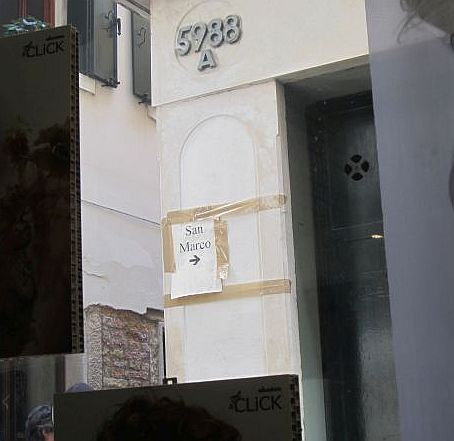

Let’s admit that “Death in Venice” is — I’m sorry to say — one of the greatest titles ever. It’s better than “Catch-22” or “Atlas Shrugged,” and it’s probably better even than “Of Human Bondage” or “Naked Lunch.”
You can see why. If sadness and Venice appear to be destined for each other, like Victorian lovers, death and Venice seem doomed to be linked forever, thanks to a genius title that connects two of the most emotion-laden words that exist. If the book had been called “Farewell, My Lovely” — which would have been kind of cool, though it would have put Raymond Chandler in a fix — at least Venice could have escaped the “death” search term.
Enough musing. A recent tragedy has shown that there’s nothing romantic about either death or Venice, even when you put them together. And you don’t have to actually die here to benefit from the Venetian element. It’s enough to be discovered to be dead here for the whole affair to seem even worse than it is. Whatever that means.
Here’s what happened. And I warn you that the tragic element, which is real, will play a relatively small part in a story which is made up of idiocy of a magnitude to dwarf even the ten most idiotic things that have ever happened here.
At about 1:40 AM on January 28, a water-taxi driver went home to the Lido and was tying up his boat at its usual place in the canal that flanks via Antonio Loredan. It was dark, obviously, and this street isn’t especially well-lighted. But he saw something floating in the water.
The “something” was the body of a woman, who was clad only in a single necklace.
But the necklace wasn’t the important clue.
It was the fact that a young Indian couple in Milan had reported her missing.
That turned out to be a huge technicolor clue, because they were the ones who killed her. This is the first indication of the level of intelligence at work here (idiocy, as mentioned). If I had murdered someone, I don’t think I’d feel like trotting over to the police to say, “She’s disappeared and I don’t know anything about it” if, in fact, I knew all about it. I’d feel like getting on a plane back to India, which is what exactly what they’d had in mind, but they didn’t do it fast enough.
 Her name was Mahtab Ahad Savoji, and she was a 31-year-old Iranian student who had gone to Milan two years ago to study art. She moved into an apartment at #5 via Pericle with Rajeshwar Singh (29), a hotel night porter, and his girlfriend, Gagandeep Kaur (30), a chambermaid.
Her name was Mahtab Ahad Savoji, and she was a 31-year-old Iranian student who had gone to Milan two years ago to study art. She moved into an apartment at #5 via Pericle with Rajeshwar Singh (29), a hotel night porter, and his girlfriend, Gagandeep Kaur (30), a chambermaid.
Life was not tranquil. Contrary to her supposition of sharing the apartment with only Gagandeep, she found herself living with her boyfriend too. The place was so small that Mahtab slept on a cot next to the sofabed where the couple had no second thoughts about getting it on whenever they felt like it. She told her friends that Rajeshwar had begun hitting on her, that Gagandeep wanted to involve her in a menage. Strife escalated.
Fed up, Mahtab packed her bag and told them she was moving out. Then she asked to be reimbursed for her part of the security deposit. As far as I can tell, this is when things went south, possibly aggravated by their feelings of rejection regarding the missed menage. In any case, they killed her.
It was 2:00 PM on January 27. The autopsy revealed that she died of “atypical strangulation,” which has yet to be further elucidated. However, her demise was not caused by a cord, as Gagandeep claimed, nor was it caused by drinking herself to death, as Rajeshwar maintained.
It’s now about 2:30 and the two Indians have a dead body they need to get rid of. They strip her, fold her up, and put her in a big rolling suitcase. Then they head to Lecco, a town 31 miles (50 km) away. The plan was to dump her body in beautiful Lake Como, but they decided against it because “there were too many people around.”

People? The town has 47,760 inhabitants, plus tourists, and it was still daylight, too. Sharp.
So they dragged the big suitcase back to Milan (presumably by train — it’s less than an hour from Lecco), and took a train for Venice.
Why? you ask. Why Venice? The Po River is much closer to Milan than Venice, and I doubt that they were impelled by the well-known romantic connection between the Queen of the Seas and the undiscovered country from whose bourn no traveler returns.
They went to Venice simply because Rajeshwar had worked in a hotel on the Lido for a brief period, so apparently it came to his mind that all that water would be just the place to leave her remains. Or some sort of reasoning like that. If he had worked in a hotel in Geneva, maybe he’d have lugged the girl’s corpse to Geneva.
They got off the vaporetto at 8:04 PM under a pounding rain; the video surveillance cameras filmed two people pulling a big suitcase. They walked a third of a mile (595 meters) to the first canal to the left, and found a nice dark spot to unburden themselves of their naked former friend.
The pair left the Lido at 9:56 PM (I can’t understand how it took them two hours to accomplish their task, but the video doesn’t lie). But when they got to the station, it was past 11:00 PM, and the last train for Milan was gone. So too was the now-empty suitcase.
Undismayed, they walked over the Calatrava Bridge and asked a taxi driver how much he’d charge to drive them to Milan, because they had to be at work the next day. (First rule of escape: Be as inconspicuous as possible.) (Second rule: Evaluate seriously how important it is to show up on time for work, when you are shortly going to be sought by the police.)
The driver said 650 euros, they said fine, and off they went. The video cameras at Piazzale Roma filmed this also.
At 2:30 AM they were back in Milan. And by now the body had surfaced.
It didn’t take the police all that long to find their way to via Pericle to ask the couple a few questions about their former roommate, thanks to their having reported her missing. At which point they began to just throw remarks every which way, like Eddie Izzard on lying: “I was on the moon. With Steve.”
First, they told the police that they’d gone out for a walk at 10:30 on the day of her disappearance, and when they returned at 6:00 PM, she wasn’t there.
Then they said that they had awakened suddenly at 8:00 AM to find her naked and dead lying on the sofabed next to him; they assumed she had drunk herself to death the night before. (So then they went out for a walk?)
The autopsy hasn’t found any evidence of this yet. On the contrary — the Indians stated that Mahtab had been eating potato chips and chickpeas with her bottomless bottle of whiskey, forgetting that the autopsy would easily reveal what she had really consumed. For the record, it was rice and vegetables, her lunch on the day of her death.
Then Rajeshwar said they hadn’t killed her, they’d only disposed of her body. (Don’t try to make sense of this. “Our friend is inexplicably dead! Gosh, let’s take her clothes off, haul her body to Venice and throw her in the lagoon so nobody thinks we did it.”)
Then Gagandeep said “Rajeshwar killed her with a cord which he threw away.” Then she said, “No, he didn’t kill her, I killed her.”
Then the police found that Rajeshwar had booked a direct flight to India for February 2, and that 5,500 euros were stashed in the sofabed.
Just think; Instead of going all the way back to Milan, they could have gotten on a plane at Marco Polo airport at 6:20 AM and been somewhere in India by 11:40 that night. I’m all for showing up for work, but I think they got their priorities slightly scrambled.
So Rajeshwar and Gagandeep are in jail in Milan, and Mahtab is in the morgue in Venice. Her aunt has come to identify her remains, and when the coroner has clarified all the remaining unclear points in the attempt to establish the definite cause of death, Mahtab will go back to Teheran.
And Rajeshwar and Gagandeep will be going back and forth from their cells to the court for quite a while.
And the good people of the Lido can go back to thinking of how to induce tourists to come to the beach and the golf course. God knows nobody wants the Golden Isle to start being known for a new kind of tourism.